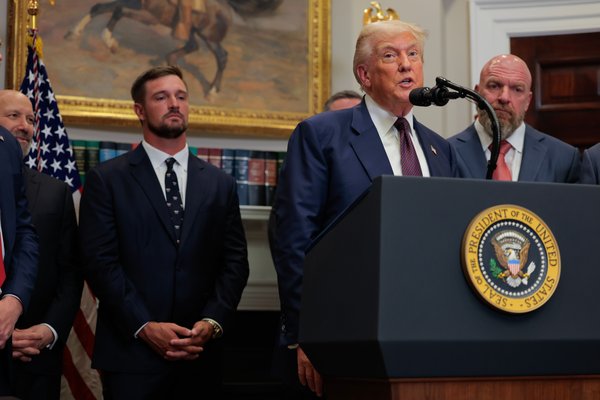Suggested Reading
Markets opened sharply lower Friday, but losses later moderated. Earlier in the session, the Dow fell more than 700 points, or about 1.6%, while the S&P 500 dropped as much as 1.9%, after Trump revealed a parade of tariffs late Thursday on dozens of countries that he said would take effect next week. The tech-heavy Nasdaq saw the steepest early losses at 2.5%, led partly by Amazon stock falling (down almost 8% in the day’s trading) after the tech giant issued a disappointing forecast on Thursday. By midday, stocks had clawed back some ground, though all three major indexes remained in the red: the Dow down 1%, the Nasdaq down 1.65%, and the S&P down 1.2%.
Related Content
The new tariffs will be applied on close to 70 countries spanning the globe from the United Kingdom to Laos, with a 15% import tax serving as the bare minimum, and threaten to upend global commerce and trigger price increases for U.S. consumers.
Separately, new data Friday showed employment growth across the U.S. was much weaker than previously thought over the last three months, suggesting that the labor market is slowing significantly. Payrolls grew by a meager 73,000 jobs, far below the roughly 110,000 anticipated in July. Adding insult to injury, May and June were revised down by a staggering 258,000 jobs — the biggest two-month revision in five years — leaving the labor market’s momentum looking weaker than it has all year.
The weak jobs data led to more calls for the Federal Reserve to cut interest rates at its next meeting in September, after it held them steady this week.
“This is a gamechanger jobs report,” Heather Long, chief economist at Navy Federal Credit Union, wrote on X. “The labor market now looks a lot weaker than expected.”
She added: “This puts a September rate cut from the Federal Reserve back on the table.”
Trump, meanwhile, continued his attacks on Fed Chair Jerome Powell, saying on his social media site Truth Social that “Powell is a disaster. DROP THE RATE! The good news is that Tariffs are bringing Billions of Dollars into the USA!”
Tariffs do not — themselves — bring money into the country. When goods are brought into the U.S., the importer has to pay the tariff. To help keep prices competitive, the foreign seller might lower their prices so the extra cost doesn’t fall entirely on the importer.
The jobs data also caused the yields — or interest rates — on U.S. government bonds to fall sharply on Friday, indicating that investors are piling into bonds.
Traders usually do this because they expect the Fed to cut rates to prop up the economy, or because they are looking for a safe-haven asset. U.S. two-year bond yields dropped 14.2 basis points to 3.811% on Friday.
—Joseph Zeballos-Roig and Shannon Carroll contributed to this article.

